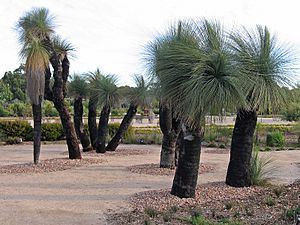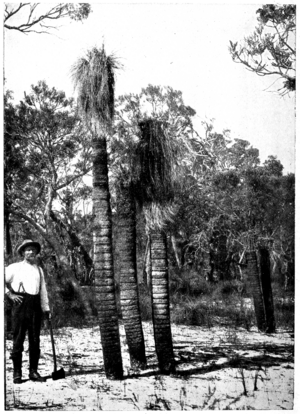Kingia facts for kids
Quick facts for kids Kingia |
|
|---|---|
 |
|
| Stand of Kingia cultivated at a garden | |
| Scientific classification | |
| Genus: |
Kingia
|
| Species: |
australis
|
Kingia is a special plant genus with only one known species, called Kingia australis. It is part of the plant family Dasypogonaceae. This unique plant has a thick, fake trunk made from old leaf bases piled up. On top of this trunk, it has a bunch of long, thin leaves. The trunk usually grows straight up without branches. However, if the very top part of the plant gets hurt, it might start to branch out.
Kingia plants grow flowers in egg-shaped groups. These flowers grow on the ends of up to 100 long, curved stems. Kingia grows very slowly, with its trunk getting taller by about 1½ centimetres each year. But these plants can live for hundreds of years! It's not unusual to find 400-year-old plants that are six metres tall.
Discovering and Naming Kingia
When Kingia australis is not flowering, it looks a bit like another plant called Xanthorrhoea. Some Xanthorrhoea plants are commonly called "blackboy" because people thought they looked like an Aboriginal boy holding a spear.
However, the flower stalks of Kingia australis are very different from Xanthorrhoea plants. Because of this, for many years, people mistakenly thought Kingia australis was a female version of the "blackboy" plant. They often called it "black gin," which is an old and offensive term for an Aboriginal woman. This name is still known by some, but it is considered inappropriate and should not be used today. Instead, people prefer to use the genus name Kingia or the Aboriginal name bullanock. The word "gin" is a short form of "Aborigine," and both these English words are now seen as offensive and racist. The Noongar name for a woman is "yorga".
Kingia and Xanthorrhoea are actually very different plants and are not closely related. For example, Xanthorrhoea plants have a special way their trunks grow thicker, which Kingia plants do not have.
The first samples of Kingia australis were collected by Robert Brown in 1801 at King George Sound. An artist named William Westall, who was on the same trip, drew the plant in his picture called View of the south side of King George's Sound. This drawing was later published in Matthew Flinders' book A Voyage to Terra Australis in 1810, and it is the first known picture of the plant. Robert Brown also wrote about the plant in this book, but he couldn't name it yet because the fruit he found was too old and damaged.
In 1823, another botanist named William Baxter collected fresh fruit and seeds of the plant. He gave these to Robert Brown. Based on these new samples, Brown finally gave the plant its own genus name in his book Character and description of Kingia in 1827. The genus name Kingia was chosen to honor both Phillip Parker King and his father Philip Gidley King. Philip Gidley King was the Governor of New South Wales when Robert Brown was exploring with Matthew Flinders. The species name australis is a Latin word meaning "southern."
Where Kingia Grows
Kingia australis is only found in the southern part of Western Australia.
How Kingia Was Used
A forest expert named Charles Lane Poole discovered that Kingia trees had a lot of a material called cellulose. This cellulose could be used to make fibers for an industry. These fibers were used to make brooms and brushes. They could be used for strong, long-lasting street brooms or for more delicate brushes. Poole noted that street sweepers in Perth and Melbourne preferred these fibers.
The fibers were taken from a layer inside the plant's trunk. This layer was separated from the soft center, dried to make it easier to work with, and then cut into lengths. These lengths were then packed into bales for shipping to other places.
The name of the genus, Kingia, was also used for the title of the Western Australian Herbarium's research publication.
Gallery
-
Kingia Australis. Phillip Parker King, 1827.
-
View of the south side of King George's Sound by William Westall contains the earliest known image of a Kingia.
-
Kingia australis at Fernhook Falls, Western Australia






